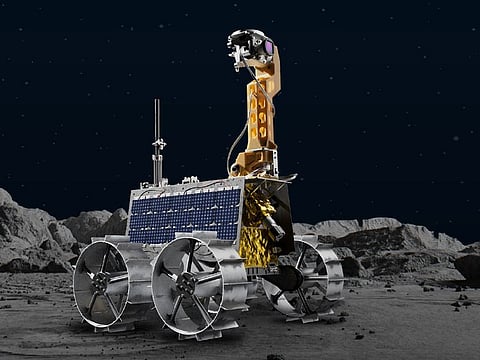Launch date, landing site of Rashid Rover announced
UAE’s lunar rover will go to the moon on Nov 28, land on lunar surface by April 2023

Dubai: UAE-made Rashid Rover is set to be launched to the moon on November 28 – at the earliest – at 12.46pm (UAE time), and is expected to land on the lunar surface by April 2023, the Mohammed Bin Rashid Space Centre (MBRSC) announced on Thursday.
MBRSC also confirmed Atlas Crater, located at 47.5°N, 44.4°E on the moon’s southeastern outer edge of Mare Frigoris (“Sea of Cold”), as the rover’s landing site. MBRSC added the date and time are subject to change, depending on weather and other conditions at launch; and the landing site was chosen “to maintain flexibility during operations”.
Multiple contingencies
“The primary landing site was chosen along with multiple contingencies, which may be used depending on variables that occur during transit. The site meets the technical specifications of the lander technology demonstration mission and the scientific exploration objectives for the ELM mission,” MBRSC said in a statement.
The first Emirati Lunar Mission (ELM) will be delivered to the lunar surface by a lunar lander built by Japanese company ispace called Hakuto-R M1, aboard a SpaceX Falcon 9 rocket that will lift off from the Space Launch Complex 40 at Cape Canaveral Space Force Station in Florida.
Rashid Rover will explore the characteristics of lunar soil, the petrography and geology of the moon, dust movement, surface plasma conditions, and the moon’s photoelectron sheath.
“The novel discovery within the unexplored lunar site is one of the many reasons why the Emirates Lunar Mission is one of the most anticipated moon missions,” MBRSC noted.
Ready for launch
Early this week, MBRSC director general Salem Al Marri has tweeted that a team from MBRSC is already at Kennedy Space Centre in Cape Canaveral, Florida for the launch of Rashid Rover.
MBRSC added the integrated launch vehicle is within the premises of Cape Canaveral Space Force Station, and will be moved to the launch pad closer to the launch date.
In a separate press statement from Tokyo on Thursday, ispace said: “The primary landing site was chosen along with multiple contingencies, which may be used depending on variables that occur during transit. The site meets the technical specifications of the lander technology demonstration mission, the scientific exploration objectives for the MBRSC mission, as well as the mission requirements of our other customers.
“Careful consideration of the target site criteria included continuous sun-illumination duration and communication visibility from the Earth. Alternative landing targets include Lacus Somniorum, Sinus Iridium and Oceanus Procellarum, among others. Landing is currently expected to take place around the end of April 2023.”
Fuel-saving route
According to ispace, the integrated spacecraft Hakuto-R M1 will take a low-energy route to the moon rather than a direct approach, which means the moon landing is expected to happen in April 2023, five months after a successful launch.
Dr Hamad Al Marzooqi, project manager of Emirates Lunar Mission at MBRSC, told Gulf News the rationale for the fuel-saving but long route. He said: “Main factor is the cost of the mission. The cost comes from the volume and mass of the spacecraft. In order to reach to the moon within six days which is the shortest path, you would need to burn a lot of fuel which means that you need a big tank and a big propulsion system to do that.”
“But it will have a huge impact in cost so, in order to reduce the cost of the mission, ispace (our partner) has selected their approach that they can reach to the lunar surface within five months but it will be less costly because it will burn much less fuel. They will use a smaller tank and propulsion system, therefore the launch cost and the cost of developing the developing system will be lower.”
Dimitra Atri, astrophysicist at New York University in Abu Dhabi, added: “In order to keep the prices of payload delivery attractive to customers, private companies reduce their expenses by choosing the lower cost option, which consumes less energy but takes much longer.”
Fully-automated landing
SpaceX Falcon 9 rocket will take Hakuto-R M1 into the moon’s orbit, and following its successful separation from the launch vehicle (rocket), Hakuto-R M1 will use the gravitational pull of the Earth and sun to guide it to the moon.
As it gets closer to the lunar surface, the Japanese-made lander will first orbit the moon with an increasingly elliptical trajectory, before angling itself vertically to softly land on the moon and performing a fully-automated landing.
Hakuto-R M1 will then establish a steady telecommunication and power supply on the lunar surface after landing to support customer payload’s surface operations, including that of the UAE’s Rashid Rover.
Sign up for the Daily Briefing
Get the latest news and updates straight to your inbox



